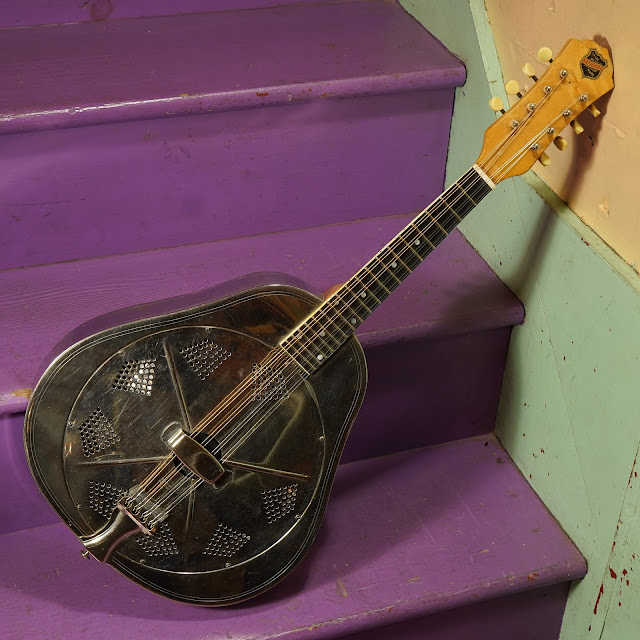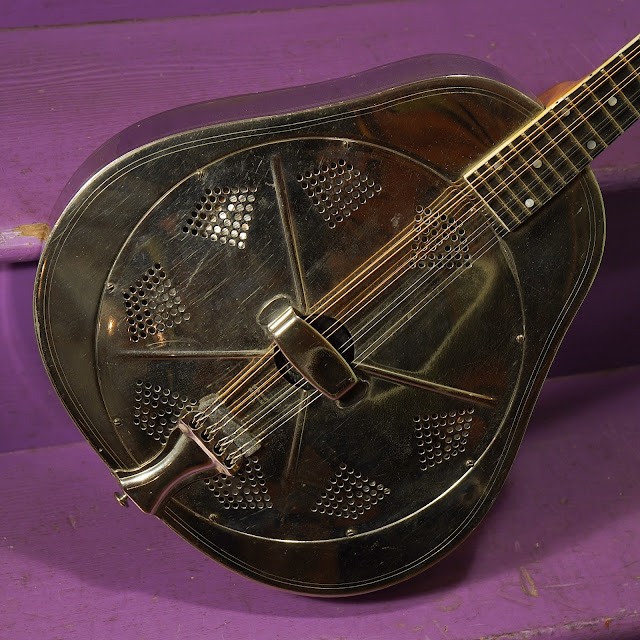1930s National Style 1 Resonator Mandolin
National mandolins in "silver" are far rarer than the much-more-common Triolian-style models with their painted bodies. This one was built right around 1930 and has a #300 serial number stamped in the headstock. It appears to have had a bunch of work done in fairly recent memory but it still needed a "glorified setup" to get it dialed-in and playing perfectly -- which it now does.
My one caveat with these instruments is that they have 15" scale lengths. Because of that, I don't really think they're suited to normal GDAE pitch (it's a lot of tension added vs 13 7/8" standard scale) except with the very lightest of strings (9s). I even have 9s on this one at the moment but still have it tuned down a full step to FCGD low to high. With 10s or 11s a half step in pitch below that -- starting at E on the low -- is delicious. You can even get down to DAEB low to high with a heavy set of mando strings!
That aside -- and I hear you ignoring me already in your brains about the tunings -- these make lovely instruments for blues, old-time, or even Celtic and jazz-ish stuff. They sound a little "bouzouki-like" right off the bat because of the ringing body.
Repairs included: a fret level/dress, bridge compensation, cone seating, additional "mushroom" bracer below the dowel near the neck joint, setup, etc.
Body: metal
Cone type: single cone
Bridge: maple
Fretboard: ebony
Neck wood: maple
Action height at 12th fret: 1/16" overall (fast)
String gauges: 32w-9 extra lights
Neck shape: slim C/soft V
Board radius: flat
Truss rod: non-adjustable
Neck relief: straight
Fret style: medium-low
Scale length: 15"
Nut width: 1 1/4"
Body width: 12 3/4"
Body depth: 2 5/8"
Weight: 4 lbs 11 oz
Condition notes: well... it's had a lot! First of all, the neck has a headstock break repair at its back (pictured) in the past that's holding pat just fine. Next, the cone is a newer replacement (National Hot Rod) cone and the biscuit has an extra thin carbon fiber wedge "foot" on it to allow for better placement under the hood. I approve of that! The biscuit/saddle appear old but I did add compensation so it'd play in tune up the neck. A strap button was added by the last guy (who also reset the neck -- and a good job of it) which runs through the back and into the dowel. That's a good idea! It makes the whole thing more stable. I added a mushroom/blocking inbetween the back and the dowel right under that bolt so that the joint is even more rigid and stable. We win! Lastly, there's a little replacement binding on the neck and the usual light scratching/usewear to the body throughout. It's very light, however, and the engraved lines, corners, etc. of the body are crisp and clean.
It comes with: ...an original hard case! That's rare as heck.




















Comments
Do you know of a modern case that fits these?
Thanks!